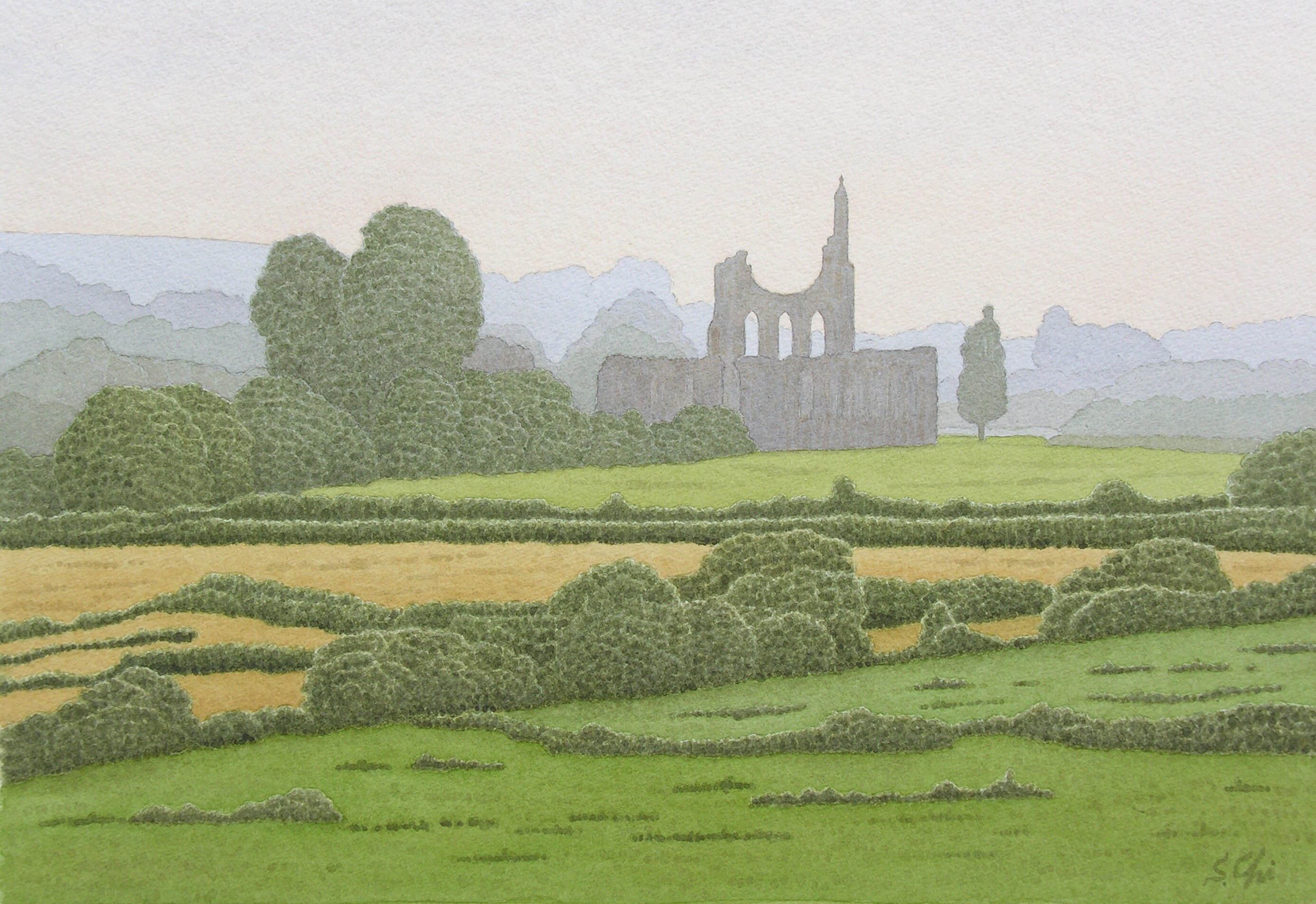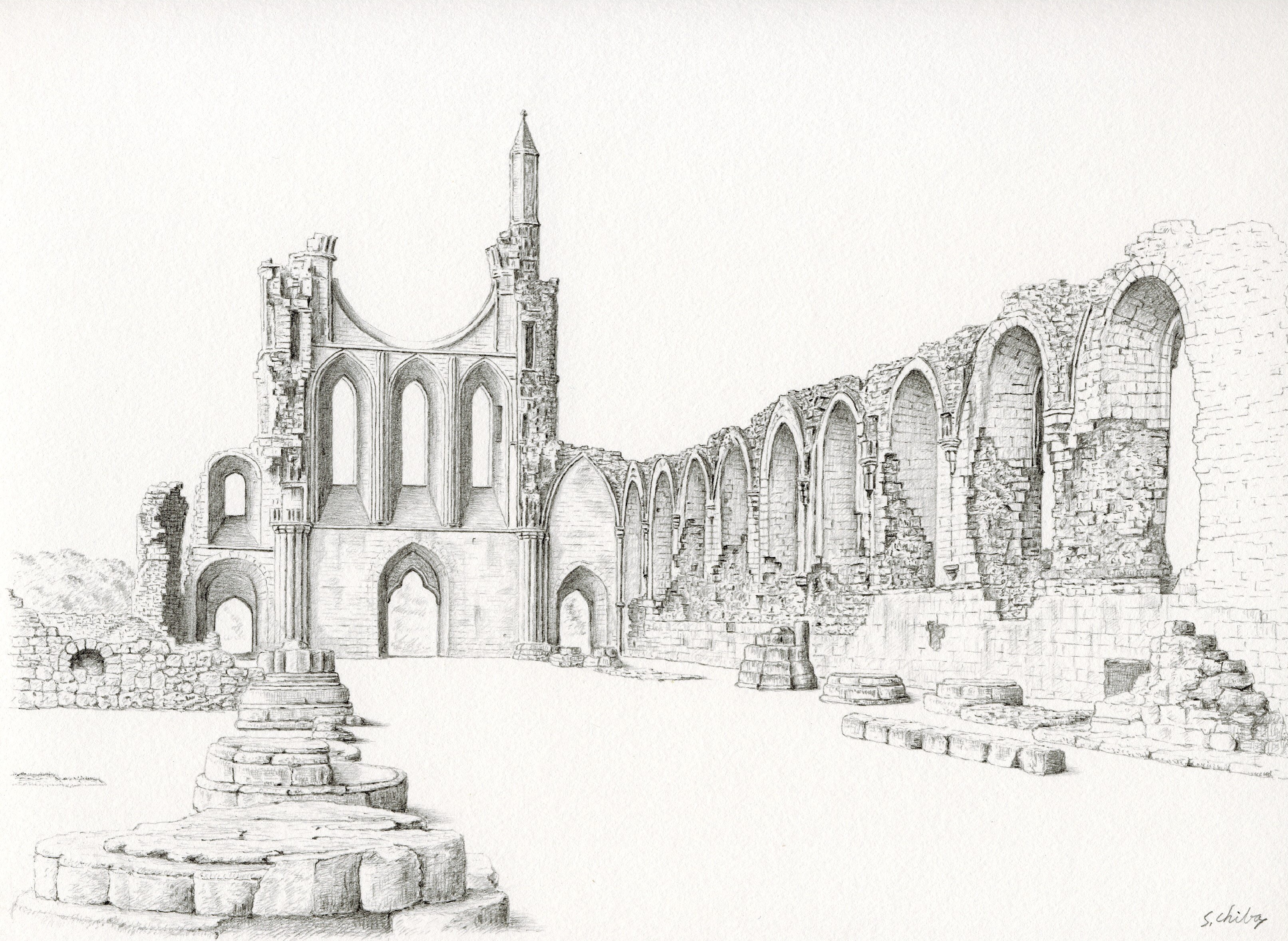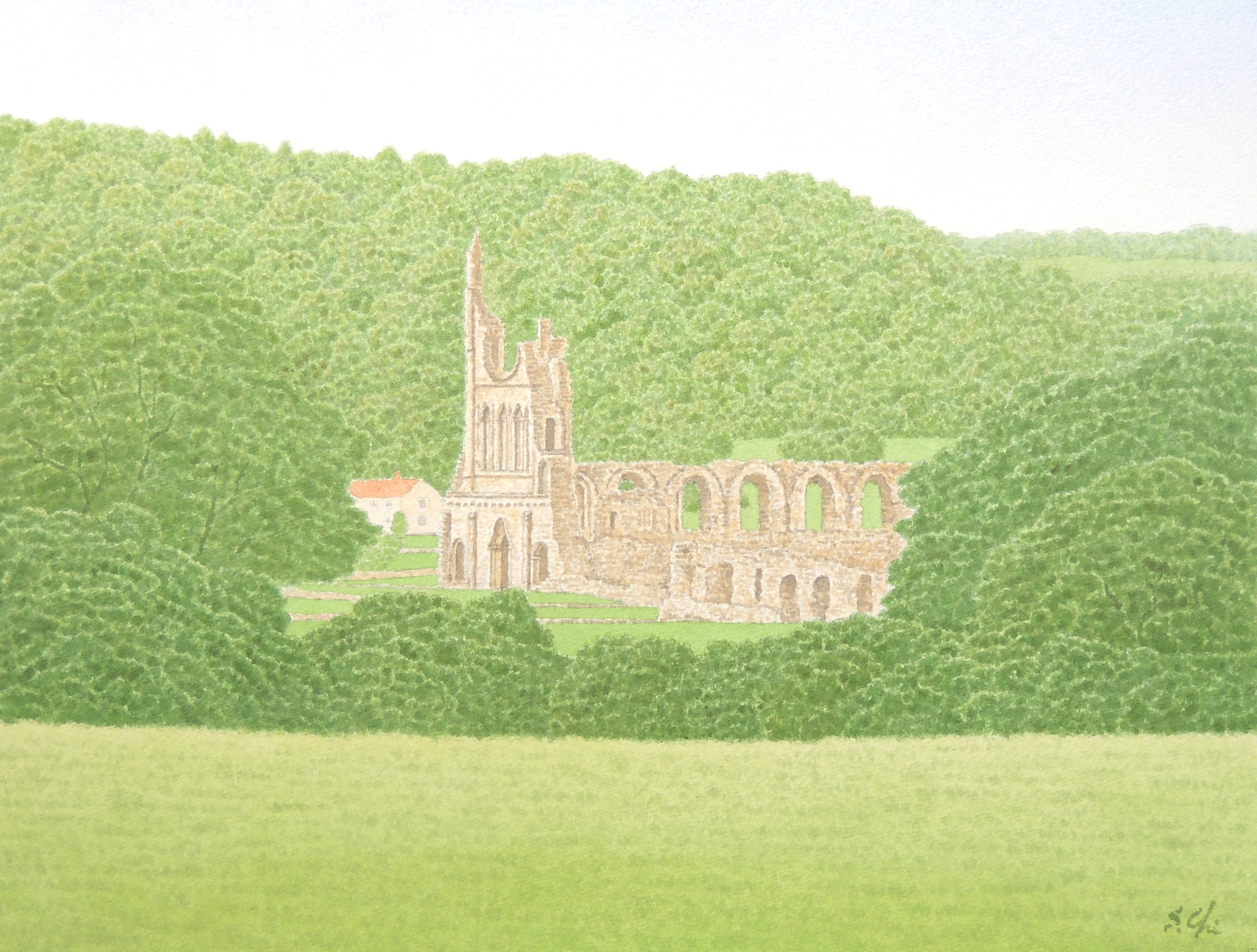
遥かなる わがヨークシャー (Faraway My Yorkshire)
ノース・ヨーク・ムーアズ (The North York Moors)
74 バイランド修道院 [コックスウォルド近く] (Byland Abbey, near Coxwold)

ハンブルトン丘陵のすぐ下、コックスウォルドから北東へ3kmほど行ったところの畑のなかに、シスターシャン修道会のバイランド修道院の廃墟がある。
この修道院を建てたのは、カンブリア州は湖水地方の最南端にあったファーネス修道院の、13人の修道士たちである。彼らは、新たな修道院を建設するために送りだされたが、その地を求めて各地をさまよい、36年もたったとき、ようやくこの地でそれがかなったという。
修道院の建設がはじまったのは1170年ごろのことで、13世紀後半に完成したとされる。解散させられたのは1538年のことである。
この修道院には、エドワード2世(在位1307-27)についての次のようなエピソードが伝えられている。
スコットランドを臣従させることに失敗していたエドワード2世は、1322年、無謀にももう一度、臣従させようと、スコットランドに侵攻した。しかし、それも失敗に終わった。
彼は意気消沈してスコットランドから撤退してきたが、勢いに乗ったスコットランド人は、彼を追撃してきた。そしてエドワード2世は、ここから北へすこし行ったところのオールドステッドであった戦いにも敗れてしまった。そこで彼は、一度バイランド修道院へ逃げ込み、そこから急いでヨークへと向かった。
ところが、兵糧や戦費のための財宝などは修道院に置いたままだったので、あとを追ってきたスコットランド人にすべて奪われてしまったという。
エドワード2世にはこればかりでなく、さまざまな失態や愚行があり、「王室史上最低の王」と烙印を押された王である。ヨークシャーにある彼のエピソードは、スカーバラ城(水彩画81)のところでも記す。
バイランド修道院は、シスターシャンのなかでも、もっとも大きい修道院の一つだったとされている。しかしいまは、聖堂の壁のほんの一部が残っているだけである。あとは瓦礫の山、ここにアビー(大修道院)があったとは、とても信じられないほど荒れている。
この廃墟でひときわ見る者の目を引くのが、上半分が崩れ落ちた西正面の北側に、一つだけ残ったピナクル(小尖塔)である。廃墟ながらも、最後の威厳を保つように天を突いているその姿は、劇的であり、悲劇的なまでに美しい。
この廃墟には、かつての修道院運動が盛んであったころの栄華を彷彿とさせるものが残っている。南翼廊の、白・緑・青・黄色の色タイルが張られた床である。
修道院の廃墟のほとんどのところで、聖堂の床は剥がされて持ち去られ、失われている。そしてその跡は、地中に埋もれ、芝草でおおわれている。
そのなかでこのバイランド修道院の廃墟は、色タイルが張られた床が見られる、数少ないところである。
かつては、聖堂全体の床に色とりどりのタイルが張られていたという。しかしその栄光に輝いていた日々は、いまは想像するほかない。
ロレンス・スターンは、このあたりまでよく散歩にきていたという。
ジョン・セル・コットマンは、崩れた西正面を1809年ごろ水彩画に描いている。ここを訪れると、その絵に描かれたままの姿が、いまも目の前にあらわれる。
わたしが9月にここを訪れたときには、崩れた壁や柱のまえに、花瓶に生けられた花や鉢植えの花が置かれていた。地元のボランティアの人たちによる奉仕活動かもしれない。
廃墟の瓦礫のなかに置かれた花、それは、滅びと生を鮮烈に対照したもので、こころに残る美しいものであった。


<New work for this website>
In the field beneath the Humbleton Hills, 2 miles to the northeast of Coxwold,
there are the ruins of Byland Abbey.
This Cistercian abbey was founded in about 1170 by the monks of Furness
Abbey, Cumbria. They had difficulties. Since thirty six years had passed
before they could build the new abbey. It was not until the late 13th century
that it was completed. The abbey had to endure much hardship, suffering
from the raids of the Scots. The abbey was dissolved in 1538.
Byland Abbey has a story involving Edward II. Having failed in a reckless
attempt to invade Scotland in 1322, he took shelter in the abbey once after
losing a battle at Oldstead, a few miles to the north. He ran away to York,
leaving his stores and treasures at the abbey. These were looted by the
Scots who were chasing him.
This deplorable episorde was one of his many actions, which led him to
being regarded as the worst king in English history.
Byland Abbey was one of the largest ones of the Cistercian order in England.
The ruins of the abbey have very dramatic and tragic appearance. Only some
parts of walls of the nave and the south transept remain. Most of the abbey
has been devastated to make mounds of debris. I could not believe there
had been once a large religious house here.
The upper half of the west front of the church fell down, leaving the half
of rim of the rose window and the lower half. Only one small pinnacle in
the north side rises to the sky. Symbolizing the tragic history of this
abbey, it seemed to me maintains the last dignity of the abbey.
On the floor of the south transept, coloured tiles of white, green, blue
and yellow still remain. It is said once the whole floors of the abbey
were covered with them. Seeing them in the ruins, I could only image the
old glorious days of the abbey.
Laurence Sterne is said to have often taken a walk around here.
John Sell Cotman painted a romantic picture of the west front of the ruined
abbey in watercolours in about 1809.
When I visited in autumn, there were flowers in vases and pots at the foot of the walls and columns. They might be offered by the local people. The flowers at ruins were so vivid and impressive, and they contrasted the beauty of the life with the vanity of devastation intensely.